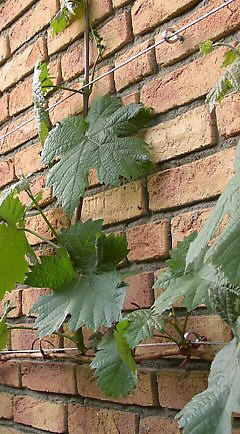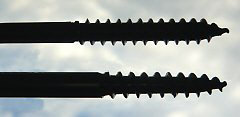Eyelet Screws and Eyebolts
This section covers stainless steel staples, eyelets, eyebolts, galvanised ground anchors, and other eyelet-screws. Here you will find the respective product sheets for all these, generally referred to as 'eyebolts.' FassadenGrün recommends eyelet screws especially for easy kitsand for some other special cases.
>>> Pricelist
Staples and Staple Nails
Stainless steel staples ('u-nails/loops' EK 02550 and EK 03510) are used to attach wire and wire-cable to wooden posts, pergolas, free-standing trellises, and lattices/trusses. They serve primarily as an intermediate mount, because here the loads are lighter than on end supports where wires are attached. The stronger staple nails KN 04055 are also used for intermediate support, and can also be used as final mounts and even be mounted in a wall with dowels (rawl plugs). When wall distance is required (the wires must not touch the wall), protruding eyebolts are required. The circular hook nail NA 04060 produces a bridge to these elements; as opposed to staples and staple nails, it creates wall distance.
Eyebolts with Wood Thread
Our eyelets and eyebolts have a shaft with a 'wood thread' and are thus suitable for plastic wall plugs or for direct mounting into wood. The lighter variant WH 06060 is suitable for very light loads, as an intermediate mount with longer ropes, and when small holes are required. Eyebolt WH 07080 is the standard screw for our easy kits. The eye screw WH 08080 is a more aesthetic variant of WH 07080 (has a better finish), as is the WH 06061 which is suitable for light loads.
Ring Bolts
Our ring bolts have a wooden thread ('metric/machine thread'), a collar, and come with a washer for through-hole mounting (for example, to balcony panels and fences). They can also be screwed into metal square pipe. FassadenGrün sells a small version WM 06030 and a larger WM 08080. The latter is also used on walls for axially loaded connections (cable system 0040), and then glued in place.
Ring Screws
Ring screws are particularly strong eye screws (bolts) with M10 thread that allow more wall clearance than other elements (6-8 cm instead of only 1-3 cm). The standard version WH 10150 is used in some medium 'classic' kits to supplement cross mounts, if deflection points are required. As a long version, the wall eyebolt WH 10180 is available. For special cases, there are the WM 10080 (for thin-walled concrete) and the WM 10100.
Earth Anchor
Earth anchors EA 12800 are basically oversized eyebolts which are fastened into the ground. They allow cables to be guided upwards and parallel to the wall without touching the wall, which can then be fastened to rafters and the like. The small earth anchor EA 10300 (also via link above) is intended for light loads and special situations.
Strain on Eye Screws
In contrast to what happens when a clothesline is stretched from a hook (see graphic), forces ("F") don't work in an axial direction with stretched wire ropes and the fastening elements, but across them. The eye screws are exposed not to tensile loads, but to buckling loads. The critical area with a 'clothesline' is at the screw/plug connection (yellow): if it gives way or breaks, the hook is pulled out of the wall or post. With an eye screw/bolt, the critical area (the load) is at the surface of the wall at the drilling point. If the eye screw bends at this point, it can be pulled out of the wall due to 'mis-alignment' (pulling at an angle).
Requirements in Fastening Systems
Depending on the fastening system and the loads it is subjected to, stress occurs differently and different requirements arise: an 'axially loaded' eyebolt -- one that is stressed in the direction of its axis ('clothesline hook' - see above)-- must be anchored especially firmly in the wall. For this reason, FassadenGrün recommends that these eyebolts be cemented or glued in the wall, as in the case of wire rope system 0040. A transversely loaded eyebolt, however, must not bend under weight. Its shaft must be as thick as possible and held in place with a suitable collared plug as a guide sleeve; at the same time it should have only a limited distance to the wall (lever arm). Please observe the recommended cable diameters (max permissible wire rope diameter) on the product sheets for individual eyebolts and screws.
Design of our Eyebolts
Standard eyebolts at FassadenGrün, like WH 07080 (for easy kits), have a thick shaft, are made of very thick metal (more material weight) and have a thread that is intricately milled. For this reason, the price is somewhat higher. For aesthetic reasons, all FassadenGrün eyebolts have a relatively small eye hole in relation to the whole screw.
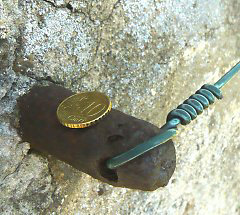
Ancient, massive, cemented iron wall mount, newly strung with wire for climbing plants, presumably Baroque period (Dornburger Locks / Thuringia)

Old eye hook with wooden wall plug and wire. Probably 19th century, winemaker's house in Radebeul / Saxony

Strain on eyebolts with a strength "F" (red) and zone of the greatest use (yellow). Above: an eye screw with "clothesline hook." Below: one single trellis rope.
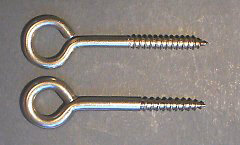
Two "6/60 mm eye screws" with 60 mm shaft length and 6mm diameter wooden thread. The shaft thickness is not designated in the model number. The upper screw is made of 5 mm wire, with a rolled wooden H6 thread; it is suitable for tensile loads. The eyelet of the lower screw is from strong 6 mm wire (WH 06060), the thread machine-cut. It is suitable for bending loads on trellis cables.
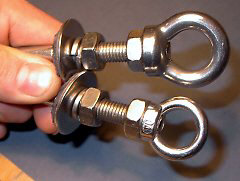
Threaded M10 eyebolt with two different heads (ring nuts). Above: ISO (International standard) version. Below: our more aesthetic version (FassadenGrün, WH 10150)

